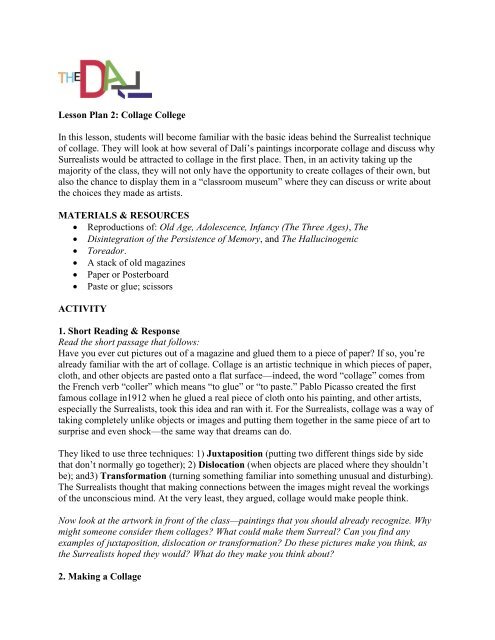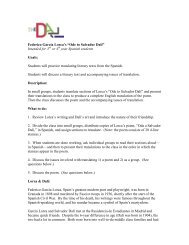Lesson Plan 2: Collage College In this lesson ... - The Dali Museum
Lesson Plan 2: Collage College In this lesson ... - The Dali Museum
Lesson Plan 2: Collage College In this lesson ... - The Dali Museum
You also want an ePaper? Increase the reach of your titles
YUMPU automatically turns print PDFs into web optimized ePapers that Google loves.
<strong>Lesson</strong> <strong>Plan</strong> 2: <strong>Collage</strong> <strong>College</strong><br />
<strong>In</strong> <strong>this</strong> <strong>lesson</strong>, students will become familiar with the basic ideas behind the Surrealist technique<br />
of collage. <strong>The</strong>y will look at how several of Dalí’s paintings incorporate collage and discuss why<br />
Surrealists would be attracted to collage in the first place. <strong>The</strong>n, in an activity taking up the<br />
majority of the class, they will not only have the opportunity to create collages of their own, but<br />
also the chance to display them in a “classroom museum” where they can discuss or write about<br />
the choices they made as artists.<br />
MATERIALS & RESOURCES<br />
Reproductions of: Old Age, Adolescence, <strong>In</strong>fancy (<strong>The</strong> Three Ages), <strong>The</strong><br />
Disintegration of the Persistence of Memory, and <strong>The</strong> Hallucinogenic<br />
Toreador.<br />
A stack of old magazines<br />
Paper or Posterboard<br />
Paste or glue; scissors<br />
ACTIVITY<br />
1. Short Reading & Response<br />
Read the short passage that follows:<br />
Have you ever cut pictures out of a magazine and glued them to a piece of paper? If so, you’re<br />
already familiar with the art of collage. <strong>Collage</strong> is an artistic technique in which pieces of paper,<br />
cloth, and other objects are pasted onto a flat surface—indeed, the word “collage” comes from<br />
the French verb “coller” which means “to glue” or “to paste.” Pablo Picasso created the first<br />
famous collage in1912 when he glued a real piece of cloth onto his painting, and other artists,<br />
especially the Surrealists, took <strong>this</strong> idea and ran with it. For the Surrealists, collage was a way of<br />
taking completely unlike objects or images and putting them together in the same piece of art to<br />
surprise and even shock—the same way that dreams can do.<br />
<strong>The</strong>y liked to use three techniques: 1) Juxtaposition (putting two different things side by side<br />
that don’t normally go together); 2) Dislocation (when objects are placed where they shouldn’t<br />
be); and3) Transformation (turning something familiar into something unusual and disturbing).<br />
<strong>The</strong> Surrealists thought that making connections between the images might reveal the workings<br />
of the unconscious mind. At the very least, they argued, collage would make people think.<br />
Now look at the artwork in front of the class—paintings that you should already recognize. Why<br />
might someone consider them collages? What could make them Surreal? Can you find any<br />
examples of juxtaposition, dislocation or transformation? Do these pictures make you think, as<br />
the Surrealists hoped they would? What do they make you think about?<br />
2. Making a <strong>Collage</strong>
<strong>The</strong> Surrealists also liked collage because anyone can do it, and that meant more artists and more<br />
people thinking about why things go together the way they do—or why they don’t go together.<br />
Your teacher has brought in some old magazines and newspapers for you to cut up and make into<br />
collages of your own Surreal world. But before you begin, you’ll need to decide on a theme.<br />
Take a minute to write some notes for yourself on apiece of paper. Will your collage be<br />
psychological? Philosophical? Political? How about dreamlike? And remember, the Surrealists<br />
enjoyed using humor, so feel free to add in funny images. Keep in mind some of the techniques<br />
that help make something Surreal: juxtaposition, dislocation, and transformation.<br />
Now go through the magazines and find images which you think symbolize your idea. Carefully<br />
cut them out and arrange them on the poster board or paper that your teacher has brought in—but<br />
don’t glue the images down yet! Arrange and rearrange them until you find the proper balance,<br />
and when you do, then glue it all down.<br />
3. Writing & Reflection (<strong>In</strong>-class or for homework)<br />
Your teacher is about to turn your classroom into a museum—and your collage is going to be<br />
part of the exhibit! As you’ll find out when you tour the Salvador Dalí <strong>Museum</strong>, however, art<br />
museums are more than just art. Most paintings are accompanied by one or two paragraphs of<br />
writing that discuss the work at hand and teach the museum’s visitors about what they’re looking<br />
at. Since your collage is on display, spend some time writing a couple of paragraphs that<br />
describe your work. What images did you choose and why?<br />
Why did you arrange them the way you did, and did you have a message you wanted to get<br />
across? Were you trying to surprise or shock? Did you try to use juxtaposition, dislocation or<br />
transformation? Did you cut out images that you ended up not using? Try to be as precise as<br />
possible—what you did might seem perfectly clear to you, but you’re the artist! To someone else<br />
who doesn’t know you, your work could be a total mystery.<br />
Teachers! Try experimenting with <strong>this</strong> exercise to make it more complex and interesting for<br />
higher-level students. Have students bring in photos from home, or provide materials for mixedmedia<br />
collages and assemblages: cloth, buttons, sandpaper, nuts, bolts, other more threedimensional<br />
materials, written text and poems, and possibly even leftover materials from shop or<br />
other studio art projects. You can even encourage students to collage their collages with other<br />
student work—which could subsequently provide opportunities for collaborative writing in the<br />
“Writing & Reflection” segment of <strong>this</strong> <strong>lesson</strong>.



